The monarch butterfly is the most beautiful and interesting creature in the insect world. Known for its large size, its orange and black wings marked by black veins and a black border with two rows of spots, the monarch’s wingspan averages 9 to 10 cm (about 4 inches) and weighs less than half a gram. They have two sets of wings, fore wings and hind wings. The underside of the wings is pale orange, so to hide from predators when the wings are closed. Monarchs flap their wings about 5 to 12 times a second, so about 300 to 720 times a minute. (This is actually quite slow compared to many other butterflies). They fly at speeds ranging between 10 to 20 kilometres an hour.
Monarch butterflies communicate with scents and colours. Male monarchs have two black spots in the centre of their hind wings, which females lack. These spots are scent glands that help males attract female mates. Females have thicker wing veins than males. The butterfly’s body is black with white markings. The colouration of the monarch butterfly warns predators of the insect’s bad taste.
When it’s raining, monarchs do not fly, they hold onto trees or bushes. If wet monarchs get knocked off these perches, they sometimes get stuck on the ground. If they’re too wet, they can’t fly because their wings are too heavy. However, monarchs do not need to stay completely dry. If they do get wet, they simply remain still until the water evaporates off their body. They often bask in the sun to dry their wings.
Monarch caterpillars is easily recognized by its vertical stripes of yellow, black, and white bands. After several moults, it attains a length of 4.5 cm (2 inches) before metamorphosis. They have a set of antennae-like tentacles at each end of their body. The monarch chrysalis, where the caterpillar undergoes metamorphosis into the winged adult butterfly, is a beautiful pale green with tiny gold spots along its edge. The caterpillar usually leaves its milkweed plant to pupate elsewhere
A caterpillar has its skeleton on its outside. Although most people refer to the outside of a caterpillar as ‘skin’, it is actually its cuticle. Its cuticle is its skeleton. The cuticle never grows. It only stretches a small amount. When the cuticle has stretched as much as it can, the caterpillar lays a mat of silk from spinnerets under its head. It attaches its anal prolegs to the silk mat. After a day, the cuticle has loosened from the caterpillar and the caterpillar literally crawls out of its old cuticle. Underneath is a new larger cuticle.
The monarch butterfly is known by scientists as Danaus plexippus, which in Greek literally means “sleepy transformation.” The name evokes the species’ ability to hibernate and metamorphize. Their Maori name is kākahu, meaning cloak.
Anatomy of the Monarch

Senses of the Monarch
Butterflies’ sensory systems help them locate food and mates, avoid predators, migrate and choose appropriate host plants for their eggs. The butterfly is a sentient creature. Like us, it has senses of touch, taste, smell, hearing and sight. However, butterfly senses don’t work in quite the same way as mammal senses. Butterflies don’t have noses or ears, but they do have six feet that do quite a lot of sensory work for them. Caterpillars can sense touch, taste, smell, sound, and light.
Touch
Feet, antennae and minuscule hairs all over its body provide the butterfly with the means to feel an object. The antennae on its head do a lot of multitasking and can sense scent, wind direction and food. A butterfly is attracted to a brightly-colored flower through both colour and smell, but it senses the smell of the nectar before it sees the flower. The antennae also help the butterfly navigate around flowers by feel. The proboscis, which is a type of nose, is used to collect nectar. This part of the butterfly detects taste through feeling the nectar, something humans can’t do.
A caterpillar’s “fuzz” gives it its sense of touch. Caterpillars sense touch using long hairs (called tactile setae) that grow through holes all over their hard exoskeleton. These hairs are attached to nerve cells, and relay information about the touch to the insect’s brain.
Smell and Taste
A butterfly uses its feet and antennae to smell the flowers. A butterfly’s antennae and feet are studded with sense receptors that are used to smell. The sense of smell is used for finding food, and for finding mates (the female smelling the male’s pheromones). The butterfly’s knob-shaped sensors on the end of its antennae pick up smells that lead it to a flower with nectar. When it lands on a flower, its feet detect the the smell of the substances in the plant and decide if they’re suitable food, or not.
A butterfly’s feet have sense organs that can taste the sugar in nectar, letting the butterfly know if something is good to eat or not. Some females also taste host plants (using organs on their legs) in order to find appropriate places to lay their eggs. These receptors (called chemoreceptors) are nerve cells on the body’s surface which react to certain chemicals. We have similar receptors in our nose and on our tongue.
A caterpillar’s maxillae (small mouth parts that are under the mandibles) have taste cells; these chemical detectors tell the caterpillar to eat when the food is appropriate, and not to eat when the food is not appropriate. The tiny antennae, which are near the mouth parts, sense smells.
Hearing
Adult butterflies often sense sound through veins in their wings. In general, butterflies have poor hearing. They sense the world mostly through smell and vision.
Caterpillars perceive sound through tactile setae, but they mainly respond to sudden noises. For example, monarch larvae often rear up if you clap loudly near them. This reaction is called a startle response, a behaviour that probably evolved to protect the larvae from predators who make noise.
Sight
The vision of butterflies changes radically in their different stages of life.
Butterflies have compound eyes and simple eyes. These eyes are made up of thousands of ommatidia, which allows it to see in various directions at the same time. It also makes it very sensitive to colour and movement. The butterfly eye can also detect ultraviolet light radiating from a flower. The eyes can also spot colour patterns on flowers that indicate where the nectar is in the flower. However, they are not very good at judging distance and the images are not united into one continuous picture. Butterflies see the world as a series of still photos rather than a movie.
Caterpillars can barely see at all. They have simple eyes (ocelli) which can only differentiate dark from light; they cannot form an image. They are composed of photoreceptors (light-sensitive cells) and pigments. Most caterpillars have a semi-circular ring of six ocelli on each side of the head.
How Do Monarchs Find Milkweed
Monarchs must find milkweed among all of the plants that grow in the spring. Monarch butterflies must use their senses to find milkweed plants in order to lay their eggs. Explore the combination of visual and chemical cues monarchs need to detect milkweed.
An Urgent Hunt
When monarchs arrive from overwintering in the early spring, milkweed is beginning to emerge. Female monarchs must find milkweed quickly. They are at the end of their lives and have eggs to lay. Milkweed is the only food monarch larvae will eat, so finding it is of the utmost importance.
A Combination of Senses
Monarchs use a combination of visual and chemical cues to find milkweed. Once they land on a plant, they use sensory organs on their feet and heads to tell them if it is a milkweed.
A Touch of Milkweed
The female flits over the field and, when she stops on a plant, she drums the surface with her forelegs. The forelegs are tiny, close to the head, and difficult to see. The forelegs help the female find milkweed.
Antennae Have Chemoreceptors
Monarchs use their antennae to detect plant chemicals. The antennae are covered with chemoreceptors, especially at the tips.
Legs Have Chemoreceptors
All six of the female monarch’s legs have chemoreceptors. Monarchs have sharp spines they can use to cut the plant and release the chemicals that tell the monarchs it’s milkweed.
Eyes
Eyes sense light, not chemicals. Monarchs have compound eyes with thousands of lenses. They see thousands of single images at the same time. Monarchs can see in all directions at the same time, too. Monarchs do not see the world in a single image the way we do. The monarch’s vision is specialized for seeing colours, direction and movement.
Confusing the Senses
Some plant species grow together in groups called ‘guilds.’ Together, the plants defend themselves by producing a mixture of plant odours. Herbivores, like monarchs, can’t find the correct host because there are too many confusing odours. This would explain why monarchs need to use a combination of senses to find milkweed.
Butterfly Wings
Butterflies use their wings to fly, to hide, and to bask in the sun. The scales on the wings let the butterflies shed moisture, so the wings aren’t too heavy for flight. The orange colour of monarch wings warns predators that monarchs are poisonous. These are just a few of the many ways to look at butterfly wings.
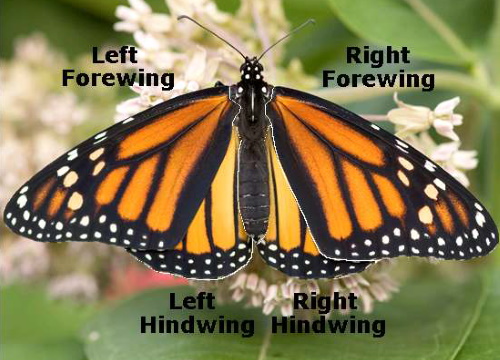
All butterflies have four wings. Two hindwings and two forewings. Small structures attach the wings to the thorax, and muscles attached to these structures move the wings. The butterfly can also move its wings by changing the shape of its thorax. Wing veins, tubes with thickened walls, contain trachea, nerves, and space for hemolymph to move through. Veins give the wings structure, strength, and support.

Monarch wings are strong. They can carry a monarch over a thousand miles. They can last over a hundred years if they're kept in a museum. But life is tough for a butterfly. Wings that begin as fresh as a flower, become faded, tattered, and torn over time. This monarch is only a few hours old. Its wings are in perfect condition.

The surface of a monarch's wing is covered with thousands of tiny, flat, colourful scales.

The scales overlap like the shingles on a house. The wings are like wax paper underneath.

Over the course of a butterfly's life, its wings can be scratched by thorns, bristles, branches, grasses or anything sharp it encounters. Wings can also be damaged by wind, hail, snow, or rain. After many scrapes, scratches, nicks, and tears, a monarch no longer appears bright orange.

As the scales are scraped off, the clear, paper-thin wing underneath becomes visible.

An old monarch looks like a ghost of its former self. When you see a butterfly, look carefully. You can get an idea of its age based on the condition of its wings. Here is a fresh, new monarch and one that is about 7 months old.
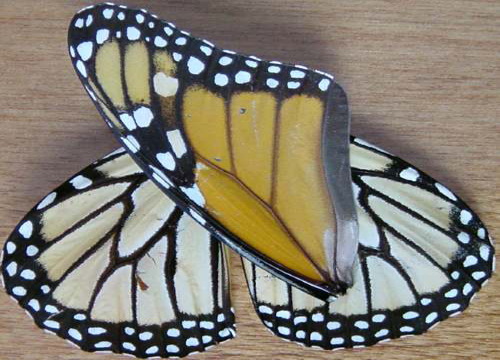
Monarch wings are brightly coloured on the upper side only. The undersides are a dull orange. Butterflies keep their wings closed when they are not flying or basking. That's how their camouflage works.

The monarchs in this picture are using their wings to hide! When their wings are closed the monarchs are camouflaged against the tree.

These monarchs are using their wings to bask in the sun! Dark colours absorb solar energy well. Basking is a way butterflies can warm their flight muscles. Monarch butterflies can't fly until their muscles are at least 15°C.
Fun Facts
The monarch butterfly is among the most recognized and studied butterflies in the world. Still, people have yet to know more about them than the iconic colour of their wings. Get to know these magnificent creatures more with these interesting monarch butterfly facts.

Butterflies don’t eat. They drink! They use their mouth, called a proboscis, like a straw to sip their food. When they’re not drinking, they roll their tongue up and tuck it under their chin.

At night, or when it’s cloudy or cool outside, butterflies land and might look like they are sleeping. But they never close their eyes. They don’t have eyelids!

Butterflies don’t have noses. They “smell” with their antennae.

Butterflies “taste” with their feet! Tiny organs on a butterfly’s feet can sense the chemical signature of anything they land on. That’s how they know if something is good to eat.

Butterflies like to sip nectar from flowers and juice from fruit, which gives them plenty of sugar for energy. But they also need salts and minerals that they get from “puddling” — drinking out of mud puddles, or wet spots on the ground.

A butterfly’s skeleton is not inside their body, but on the outside and is called the exoskeleton. Its like having skin made of bones. They have muscles just like we do, and that’s how they move.

A butterfly has four wings. A pair of fore wings in the front and two hind wings in the back. When they fly, their wings move up and down in a figure-eight pattern. A group of butterflies flying together is called a “flutter!”

Butterflies don’t need to do much communicating. They sometimes move their wings to send a message. And because they can see ultraviolet light, they look for the ultraviolet light patterns on each others wings that identify their species and gender.

The female monarch can smell a swan plant from 2 kilometers away.

The common milkweed plant is called a swan plant for a reason! The flower pods that contain the seeds look like actual swans. These will appear at the end of the season if the hungry caterpillars don’t strip the plant to just the stems, which happens in many cases.

Monarchs undergo the longest recorded two-way migration of any insect. Up to four generations of Monarch complete a round trip of approximately 8,000 km.

You can the gender of the butterfly while in chrysalis . A vertical line at the top of the body of the first ring of the chrysalis just below the two black dots means a girl. No line means a boy.

In order for these delicate creatures to fly, their wing muscles must stay above 12 degrees Celsius.

Caterpillars eat only milkweed, which contains a poisonous chemical that protects them from predators. The chemicals stay in their system to make even the adults taste bad. Bright orange wings let predators know the butterflies are poisonous.

Butterfly wings are densely covered with scales that improve their aerodynamic efficiency. The upper surface of the thorax is covered with long hair-like scales that help retain heat.

Monarchs are in the butterfly family Nymphalidae. Members of this family appear to have only 4 legs, but they really do have 6. The front pair of legs is greatly reduced in size and tucked up under the head.

Monarchs are so named because their orange colour was associated with King William of England, an English monarch who had been the Prince of Orange in the Netherlands.

Monarch butterflies are found throughout the United States, Hawaii, central America, south America, southern Canada, southern Portugal and Spain, Caribbean Islands, Australia, New Zealand, and other Pacific Islands.

Monarch Butterfly caterpillars eat and grow until they burst out of a small skin into a bigger one. Monarchs go through five skins (instars). A caterpillar eats its old, outgrown skin.

Monarch Butterfly caterpillars excrete digested plant material, which is called frass.

Monarch Butterflies do not have lungs, but have tiny vents called spiracles along the sides of the thorax and abdomen. Air enters the spiracles and is dispersed through the body by microscopic tubes called tracheae.

Monarch butterflies communicate with scents and colours. To mate, the males attract females by releasing chemicals from scent glands on their hind wings.

The average travelling speed of monarch butterflies is known to be about 9 kilometres an hour and can reach a maximum speed of about 19 kilometres an hour. Often the flight of these butterflies is described as slow and sailing.

Monarch butterflies use a combination of visual and chemical cues to find milkweed. Once they land on a plant, they use sensory organs on their feet and heads to tell them if it is a milkweed.

Swan plants contain cardenolides, which is a nutrient inside the plant that helps the caterpillar form a chrysalis.
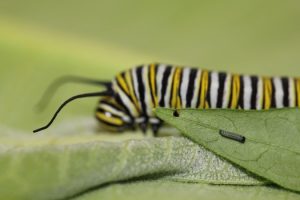
In 2–3 weeks, the caterpillar grows to about 2,700 times its birth weight! Comparison between a 5th instar and a newly hatched 1st instar.

The head has a set of filaments, mouthparts (upper lip, mandibles, & lower lip), & 6 pairs of simple eyes called ocelli.

The thorax has 3 pairs of true legs & each leg has a single claw. The abdomen has 5 pairs of prolegs (false legs) for support at rear. False legs have pads at the ends with sticky hooks called crochets.
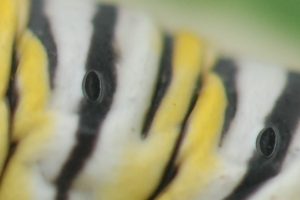
They obtain oxygen through holes in sides of thorax & abdomen called spiracles which connect to air tubes (trachea). The spiracles are in their cuticle, like our skin. Monarchs don't have lungs, the trachea carry oxygen throughout the monarch's body.

The spinneret at bottom of head produces silk, to help anchor itself to the plant. The most prominent white structure with a black band around it in which its silk glands are located.

When shedding and during windy days a monarch caterpillar will produce silk (similar to spiders) in order to anchor itself to the leaf. Silk is one of the strongest natural fibers.
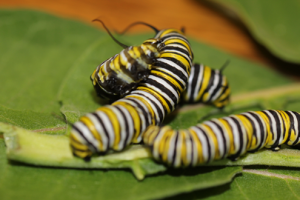
When touched, the caterpillars will rear their heads and lunge at the intruder - perhaps to drive them off.

When large enough, the caterpillars will stop eating and begin to move around more - even leaving their host plant entirely in search of a safe place to pupate.

Chrysalis is a Greek word for gold and describes the gold bands and spots that appear on the pupa.
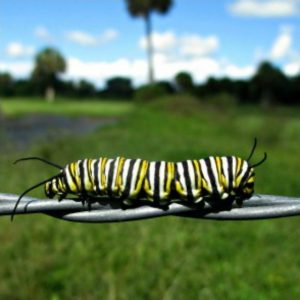
Pair of soft, black filaments (sense organs) at each end of their body. Filaments behind the head wiggle when it feeds.
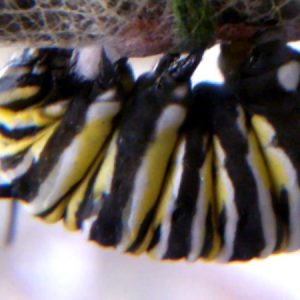
Each leg has a single claw & the spinneret at bottom of head also produces silk, to help anchor itself to the plant.

Chrysalis is a Greek word for gold and describes the gold bands and spots that appear on the pupa.

Pair of soft, black filaments (sense organs) at each end of their body. Filaments behind the head wiggle when it feeds.

Each leg has a single claw & the spinneret at bottom of head also produces silk, to help anchor itself to the plant.
